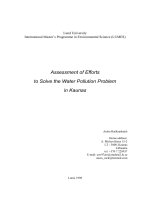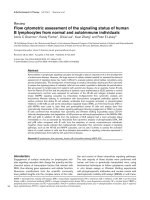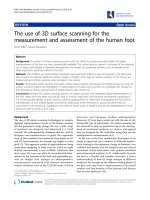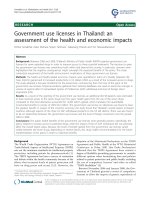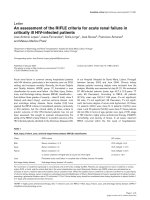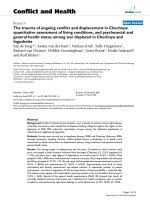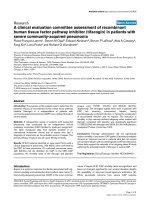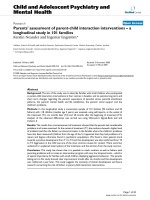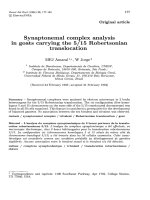Assessment of status of exploitation and use of tam dao salamander (paramesotriton deloustali bourret, 1934) in tay thien, tam dao national park
Bạn đang xem bản rút gọn của tài liệu. Xem và tải ngay bản đầy đủ của tài liệu tại đây (1.07 MB, 87 trang )
MINISTRY OF AGRICULTURE AND RURAL DEVELOPMENT
VIETNAM FORESTRY UNIVERSITY
STUDENT THESIS
Title
ASSESSMENT OF STATUS OF EXPLOITATION AND TRADE OF TAM DAO
SALAMANDER (Paramesotriton deloustali Bourret, 1934 ) IN TAY THIEN, TAM DAO
NATIONAL PARK
Major: Natural Resources Management
Code: D850101
Faculty: Forest Resources and Environmental Management
Student: Nguyen Thi Ha
Student ID:115 309 1138
Class: K56 Natural Resources Management
Course: 2011 - 2015
Advanced Education Program
Developed in collaboration with Colorado State University, USA
Supervisor: Dr. Dong Thanh Hai
Ha Noi, 10/2015
1
Abstract
Tam Dao salamander (Paramesotriton deloustali), also known as Tam Dao newt, an endemic
amphibian to the mountains of Vietnam. It is listed as vulnerable (IUCN, 2015), in group IIB
of species that is restricted to exploitation and trade under commercial purposes in Decree
No. 32/2006/ND-CP of Vietnam government. The status of exploitation and trade on this
species is increasing as a profound matter due to the fast growth of eco-tourism in Tay Thien
area in recent years. Besides that high profit from illegal trade, lack of knowledge, ineffective
policy implementation and enforcement are additional drivers of this trend. The aims of this
study are 1) investigate the status of P.deloustali population and its main threats, 2)
investigate how this species are being exploitation and trade, and 3) determine factors that
drive the participation of locals in trade and harvest this animal in recent years. Results show
that the status of Tam Dao newt population declined significantly in the period of 10 years up
to now. The top ranked threats that led to this trends were waste from tourism activities,
construction, and illegal harvest and trade. The status of harvest and trade of this endemic
species had taken place in this area for a long time ago with very sophisticated trading flow
and form of hiding to avoid the discoverable of authorities. The period after establishment of
Tam Dao national park (1996-2010) was reported as the hottest time of exploiting and
trading. The primary motivation for hunt this species was for sale instead of for subsistence
use as mentioned in some literatures. 10 sale points with totally 31 individual of Tam Dao
salamander was observed during the study, even in a short period of time and in low tourism
season. Thus, the study concludes that the status of exploitation and trade of P.deloustali is
popular in Tay Thien area. In addition, there are four factors are proven to influence in the
participation of people in hunting and trading of this species are: sex, educational level,
markets, and livelihoods. Among these factors sex and markets provide strongest effect in
process of making decision.
2
Acknowledgements
This report is submitted for the Advanced Education Program Developed in collaboration
with Colorado State University, USA, faculty of Forest Resources and Environmental
Management, Vietnam Forestry University. This study would not have been possible without
the kindness help of many individuals and institutions. Most importantly, I am very grateful
to my supervisor Dr. Dong Thanh Hai for his guidance, instruction, and encouragement at
every step of my study and for sharing his knowledge and ideas with me. I specially thank to
Professor Lee MacDonald for his taking time in advising in writing and correcting my thesis
proposal. I would also like to acknowledge Mr. Tran Van Dung for his kindly assisting me in
mapping.
I would like to thank the Tam Dao National Park (NP), Dai Dinh Committee, and Dai Dinh
Ranger Station for their permission and support to undertake this study. In particularly, for
Head of Science, Technology and International Cooperation Department Mr. Le Thanh
Cuong, Mr. Vu Van Quyet, Mr. Nguyen Duc Toan for their provided documents and human
resources support. I would like to show my gratitude to the villagers who were patient and
kindly answered my questions during the field survey.
I express deep gratitude to my parents, my brothers, and my sisters who encouraged and
inspired throughout the study, without their support this report would have not been possible.
3
Table of contents
Abstract
Acknowledgements
Abbreviations
List of Photos
List of Figures
List of Tables
CHAPTER 1 .............................................................................................................................. 9
INTRODUCTION ..................................................................................................................... 9
CHAPTER 2 ............................................................................................................................ 11
LISTERATURE REVIEW AND THEORITICAL FRAMEWORK ...................................... 11
2.1. Listerature review ......................................................................................................... 11
2.1.1.
Trade patterns..................................................................................................... 11
2.1.2. Conservation Status .............................................................................................. 12
2.2.
Theoretical Framework ............................................................................................. 13
2.2.1.
Key definitions and terminology used in this report .......................................... 13
2.2.2.
What are the socio-economic drivers the exploitation and trade of wildlife? ... 14
CHAPTER 3 ............................................................................................................................ 19
GOALS AND OBJECTIVES .................................................................................................. 19
3.1.
Goals.......................................................................................................................... 19
3.2.
Specific objectives..................................................................................................... 19
3.3.
Research questions .................................................................................................... 19
3.4.
Research hypothesis .................................................................................................. 20
CHAPTER 4 METHODS ........................................................................................................ 22
3.1.
Selection of study site ............................................................................................... 22
4
3.2.
Overview of study site............................................................................................... 23
3.3.
Methods ..................................................................................................................... 24
3.3.1.
Secondary data ................................................................................................... 24
3.3.2.
Line transects ..................................................................................................... 25
3.3.3.
Interview ............................................................................................................ 26
3.3.4.
Map the hot spots of exploiting and trading of P. deloustali in Tay Thien........ 27
3.3.5.
Data analysis ...................................................................................................... 28
CHAPTER 5 RESULTS .......................................................................................................... 30
5.1. Population status of P.deloustali in Tay Thien. ............................................................ 30
5.2. Status of exploitation and use of P.deloustali Tay Thien ............................................ 32
5.2.1.
Evidences and traces of P.deloustali being harvested, and traded in Tay Thien
area
32
5.2.2.
Seasonal presence and selling seasons ............................................................... 35
5.2.3.
Hunting techniques ............................................................................................ 36
5.2.4.
Responsible person for hunt............................................................................... 36
5.2.5.
Purposes of exploiting P.deloustali ................................................................... 37
5.2.6.
Form of hidding, and evading P.deloustali from paltrol and control of
authorities......................................................................................................................... 38
5.3.
The trade of Tam Dao salamander in Tay Thien ...................................................... 38
5.3.1.
Market, price, and form of selling over each periods: ....................................... 38
5.3.2.
Market and trading flow of P.deloustali ............................................................ 40
5.3.
Map hotspots of P.deloustali being sold in Tay Thien area ...................................... 45
5.4.
Drivers of the exploitation and trade of P.deloustali in Tay Thien........................... 46
5.4.1.
Factors that had determined the harvesting and selling of P.deloustali in Tay
Thien area in the past. ...................................................................................................... 46
5.4.2.
Drivers of the participation of exploitation and trade of P.deloustali in present
time?
50
5.5.
Key threats to P.deloustali populations in Tay Thien ............................................... 51
5
CHAPTER 6: DISCUSSION ................................................................................................... 55
6.1. Livelihoods ................................................................................................................... 55
6.2. Markets and prices ........................................................................................................ 56
6.3. Legislation and regulations ........................................................................................... 57
6.4. Conservation awareness ................................................................................................ 58
6.5. Resource management practices ................................................................................... 58
6.6. Sex................................................................................................................................. 58
6.7. Age ................................................................................................................................ 59
6.8. Educational level ........................................................................................................... 59
6.9. Occupation .................................................................................................................... 60
6.10. Average monthly income per capital .......................................................................... 60
CHAPTER 7: CONCLUSIONS & RECOMMENDATIONS ................................................ 62
REFERENCES ........................................................................................................................ 66
APPENDICES ......................................................................................................................... 72
6
Abbreviations
CITES
The Convention on International Trade in Endangered Species of
Wild Fauna and Flora
IUCN
International Union for Conservation of Nature
NP
National Park
NTFPs
Non-timber Forest Products
P.deloustali
Paramesotriton deloustali
List of figures
Figure 2.1. Assumptions of factors that drive the participation in P.deloustali exploitation and
trade (TRAFFIC 2008, modified) ............................................................................................ 18
Figure 4.1: Map of study site Dai Dinh commune, Tam Dao district, Vinh Phuc province ... 23
Figure 5.1. shows the comparision of assessment of the interviewees on the status of Tam
Dao salamander population in 2005 and 2010 with the current time of the study (2015). ...... 32
Figure 5.2. Distribution of P.deloustali in Tay Thien area ..................................................... 31
Table 5.1.Represent the results of 10 sale points where P.deloustali were sold in Tay Thien 33
Figure 5.3.Compare the percentage of participation of local people in harvesting and
exploiting P.deloustali in past and current time. ...................................................................... 35
Figure 5.4. Compare the differences between seasonal appearance and trading season of
P.deloustali in Tay Thien area. ................................................................................................ 36
Figure 5.5. Show the motivation of hunting for P.deloustali through responses. ................... 37
Figure5.6. Show the trading flow diagram of P.deloustali in Tay Thien area from 2000-2010 .
Figure5.7.Show the sale points of P.deloustali observed during study in Tay Thien area. ..... 45
List of Table
Table 4.1. Species composition of Tam Dao NP ..................................................................... 24
Table 4.2. Summary table of transects line at Tay Thien area, Tam Dao National Park......... 25
Table 4.3.Distribution of interview object ............................................................................... 26
Table 4.6. Basis to define poor and near-poor household in rural areas in Vietnam in period
2011-2015 ................................................................................................................................ 26
Table 4.7. Basis to define moderate and rich households in Dai Dinh commune ................... 27
7
Table 4.8. Basis criteria to assess the degree of illegal exploitation and trade of wildlife ...... 27
Table 4.9. Description of assumption variables which influence the participation in exploiting
and using of P. deloustali......................................................................................................... 28
Table 4.10. Criteria to assess the level of conservation awareness of respondents ................. 29
Table 5.2. Show the results of binary logistic regression model test on independents factors
that were assumed to have influence on the participation in exploitation and trade of local
people in study area ................................................................................................................. 48
Table 5.3.Summary results of assessment of threats to P.deloustali populations in Tay Thien
.................................................................................................................................................. 51
List of photos
Photo 5.1. Shows the P.deloustali was sold in plastic bottles in Tay Thien area. ................... 34
Photo 5.2 Waste from tourism activities in Tay Thien ............................................................ 52
Photo 5.3. Local people collected NTFPs near Co temple ...................................................... 53
8
CHAPTER 1
INTRODUCTION
Wildlife trade is becoming a big business, in Vietnam and other Asian countries. Illegal
trafficking in wildlife in Asia is almost beyond control. Wild animals are hunted, killed and
captivity on a large scale, in order to satisfy the huge demand for bush meat, fur, traditional
medicines derived from wildlife, livestock and pet needs (Nguyen Van Sang et al., 2003).
Some animals are at risk of near extinction, others are becoming increasingly rare. Therefore, it
is raising the need for research to sustainable conservation management.
Tam Dao salamander (Paramesotriton deloustali), also known as Tam Dao newt, is an
endemic amphibian to the mountains of Vietnam. According to IUCN Red List of Threatened
species, Tam Dao salamander is listed as VU. It is also listed in group IIB of Decree No.
32/2006/ND-CP of Vietnam government of species that is restricted to exploitation and trade
under commercial purposes. Since 1992, Tam Dao newt has listed in Vietnam Red data book
(Ministry of Science and Technology. 1992) that only can be found in Vietnam, and it is in
level B (near extinction).
Tay Thien is a famous historical, scenic tourist attraction of Tam Dao NP, because it meets all
three factors: culture, religion, and beautiful natural landscape. Therefore, it not only attracts
tourists in high season, but all year around. In recent years, the tourism boom has brought
many benefits to the local economy, but partly destroyed the natural beauty, caused
environmental pollution and lost biodiversity of Tam Dao NP, and the surrounding area.
According to the herpetological survey report (Nguyen Quang Truong et al., 2004) the
population of Tam Dao salamander are mostly detected in Dai Dinh commune in Tay Thien
area. Therefore, tourism activities might lead to various impacts on Paramesotriton deloustali
(P. deloustali) population in either its habitat or population size and richness.
The Global Amphibian Assessment (IUCN, 2015) reported that P. deloustali was used at
subsistence level for food (human), at subsistence level and nationally for medicine (human
and veterinary) and nationally and internationally for pets/display animals. They estimated that
0-25% of specimens in commercial trade were wild-sourced. The trend in the level of wild
offtake/harvest in relation to total wild population numbers over the last five years was
reported to be increasing (IUCN, 2015). Nguyen Van Sang et al., (2003) reported that in
northern Viet Nam, P. deloustali was sold at local markets and in villages for pets; that the dryform was used as a traditional medicine to cure diseases such as asthma and rickets; and that
9
the species was rarely eaten by local people, apparently because of its bad smell and strange
body form. The local pet trade was thought to be the main reason for the decreasing population
at Tam Dao National Park (Nguyen Van Sang et al., 2003).
Therefore “Assessment of status of exploitation and trade of Tam Dao salamander
(Paramesotriton deloustali Bourret, 1934) in Tay Thien; Tam Dao National Park‟‟ is vital
important. The aims of this research are to: 1) investigate the status of P.deloustali population
and its main threats, 2) investigate how this species are being exploitation and trade, and 3)
determine factors that drive the participation of locals in trade and harvest this animal in recent
years. Thus, this study will play a role as a basic for proposing better management measures,
and effective biodiversity conservation of P. deloustali in Tam Dao NP, as well as its buffer
zone.
10
CHAPTER 2
LISTERATURE REVIEW AND THEORITICAL FRAMEWORK
This chapter is going to review all relevant documents, papers, publications, etc that
mentioned about the conservation, exploitation and trade status of P.deloustali throughout
the countries, as well as international. Also, it provides basis theory about what factors drive
the participation in wildlife trade, and some key policies which are implemented aiming to
conserve and prevent illegal wildlife trade..
2.1. Listerature review
2.1.1. Trade patterns
P.deloustali was sold at local market and villages for pets, and dry-form was used for
medicinal purposes to cure diseases such as asthma and rickets, and local people hardly ate
them because of its bad smell, strange appearance. But it just caused a minor effect on the
population of this species (Nguyen Van Sang, et al., 2003). In other word, this kind of use
and trade of Tam Dao salamander was in insignificant level that was not harmful for species‟
status and population size in general. Author stressed that, the main reason for the decreasing
population of P.deloustali was from local pet trade (as cited in UNEP-WCMC, 2006)
The Global Amphibian Assessment reported that P.deloustali was used at subsistence level
for food, at subsistence level and nationally for medicine, and nationally and internationally
for pets/display animals. They estimated that 0-25% of specimens that was founded in
commercial trade were wild-sourced (as cited in UNEP-WCMC, 2006). The trend in the level
of wild offtake/harvest in relation to total wild population numbers over the last five years
was reported to be increasing (IUCN, 2006). Whereas, According to the Report of non-cities
amphibian (UNEP-WCMC, 2006) reported that no national trade statistics were identified for
this species. Thus, the data about the trade status of this species was unclear, it requires more
study need carrying out.
The presence of specimen of this species in markets for sale in both dry and alive forms was
reported in many studies with variability of time range. Although occurrence of this species
in trade was thought to be rare (Nguyen Xuan Dang et al, 2003; Miller, 2004, Tran Van Cu,
2007; Trinh Khac Cuong, 2007; Nguyen Thuy Ngan, 2010; Vu Van Quyet, 2011).
In comparison with report of Nguyen Van Sang, there is the existence of number of people
who used this species as one sources of food. The level of trade for medicinal purpose was
not only at locally but also nationally, even at higher level and bigger scale. So it can be
11
assumed that the status of use and trade of P.deloustali was increasing in both scale and level
in the years between 2003 and 2006 and still existed in the following years.
5.2.1. 2.1.2. Conservation Status
Conservation status: P. deloustali is listed as Vulnerable, distribute in less than 2,000 km2,
with all individuals in fewer than ten locations and a continuing decline in the extent and
quality of its habitat, and in the number of mature individuals (IUCN, 2015)
Distribution: P. deloustali was originally known only from the Tam Dao mountain ridge in
northern Viet Nam. However, it has since been recorded in more than ten localities in Bac
Kan, Ha Giang, Yen Bai, Tuyen Quang, Tay Nguyen, and Lao Cai Provinces, all in Viet
Nam. They reported that its population was apparently relatively stable and that is was not
particularly rare locally (IUCN 2015). Whilst, population of this species reported to decline
significantly (Tran Van Cu, 2007). Especially, it was reported that “In 1997, P. deloustali
were considered extinct in the wild (Miller, 2004).
Major threats:
Major threats to P. deloustali was habitat loss, due to agriculture and human settlement,
pollution, and harvesting for food, medicine and the pet trade, are threats to this species
(Tordoff, 2002, Nguyen Van Sang, 2003; Tran Van Cu, 2007, IUCN, 2015). As a results of
political and economic changes, with logging, construction, industrialization, and
development for tourism (Miller, 2004). Besides that, natural reproductive coefficient of
P.deloustali is not high.
“Presently, there is no particular program for salamander conservation in Vietnam.” (Nguyen
Van Sang et al., 2003). It was recommended that managed ex-situ assurance colonies among
zoos and competent hobbyists should be set up to aid conservation of this species (IUCN
2015).
In summary, there were a few studies referred to P.deloustali, but it just focused on detecting
the distribution area, and behavior of the species. Data about exploitation, trade, and use of
this species are too general. Or only report about the presence of specimens being sold
without understanding deeply the causes and motivations of the harvest and trade. Also, no
documents described in detail of seasonality, techniques of hunting, markets and the prices.
Tam Dao NP is the first place recorded the presence of Tam Dao salamander. Tay Thien is
believed to have big population of this species. In contrast, no research has been carried out
in there despite the status of exploitation and trade of this species has existed long time ago.
Because the existence and fast growing of tourist activities in Tay Thien with more than 10
12
million visitors visited there each year (Tam Dao NP, 2008) will create enormous pressure on
the management and conservation of the species. Therefore, this study was conducted aiming
to collect information on illegal exploitation and trade, the causes and motives of hunters in a
comprehensive and more specific way. It will provide an overview for the authorities,
managers, organizations, and conservationists about the current status of trade and use of
P.deloustali in order to take better management measures.
2.2. Theoretical Framework
2.2.1. Key definitions and terminology used in this report
Drivers are understood as the forces, conditions or factors that lead people
Economic and
social drivers
to behave in a particular way. In this report, economic and social drivers
are considered in the context of the economic and social conditions that
lead people to harvest, trade or consume wildlife in an illegal and/or
unsustainable manner (TRAFFIC, 2008)
A livelihood comprises the capabilities, assets (including both material and
social resources) and activities required for a means of living. A livelihood
Livelihoods
is sustainable when it can cope with and recover from stresses and shocks
and maintain or enhance its capabilities and assets both now and in the
future, while not undermining the natural resource base. (DFID, 2008)
Market-based instruments are designed to affect the demand and supply
conditions facing individuals and enterprises. Instruments that alter market
conditions directly include imposition or removal of taxes or subsidies that
Market-based
change cost or demand conditions, or product designations (such as
instruments
labelling or certification) that change demand conditions. Marketmimicking instruments include tradable permit systems, or other methods
that establish tradable property rights or remove barriers for trading.
(Farber and Tietenberg, 2006)
Wildlife trade is any sale or exchange by people of wild animal and plant
resources. This can involve live animals and plants for the pet and
Wildlife trade
horticultural trades, or the trade in a diverse range of wild animal and plant
products needed or prized by humans – including skins, medicinal
ingredients, tourist curios, timber, fish and other food products (TRAFFIC,
2007)
Conservation
Conservation awareness encompasses landowner/local people knowledge
13
awareness
of, familiarity with, and experience with forest conservation options and
sources of information that support informed forest management decisions
(Van Fleet et al 2012.).
Resource management is the efficient and effective development of an
Resource
organization's resources when they are needed. It is also processes,
management
techniques and philosophies as to the best approach for allocating
resources have been developed (en.wikipedia.org, 2015).
Law enforcement broadly refers to any system by which some members of
Law
society act in an organized manner to enforce the law by discovering,
enforcement
deterring, rehabilitating, or punishing people who violate the rules and
norms governing that society (en.wikipedia.org, 2015).
2.2.2. What are the socio-economic drivers the exploitation and trade of wildlife?
Economic and social factors drive both demand and supply sides of the wildlife trade
equation, to improve either biodiversity conservation or development returns as these relate
to the use and trade of wild resources needs to be considered of theses drivers and to design
actions in a way that take them into account (TRAFFIC, 2008)
According to the report on „‟what‟s driving wildlife trade?‟‟ (TRAFFIC, 2008) there are a
variety of social-economic factors that drives the illegal trade on wildlife, but there are 5
main drivers as listed below:
Livelihoods as drivers:
reducing poverty, increasing income and/or diversifying
livelihoods among rural communities would reduce participation in harvesting
wildlife to supply the illegal and unsustainable wildlife trade. Data from northern Lao
PDR, for example show that poorer households are much more dependent upon
income generated from forest plants and animal than less poor households (Emerton,
2005). There is some evidence that poorer people are more likely to be seasonal
harvesters, using the wildlife trade as a safety net at critical time during the year
(TRAFFIC, 2008). However, the link between wealth, poverty and engagement in the
wildlife trade are complex: people involved in the trade are not necessarily poor, and
the poor who are involved usually do not drive the trade. Indeed, the trade in wildlife
in the region involves some extremely wealthy individuals and groups (Compton et
al., 1999; Nooren and Claridge, 2001 as cited in TRAFFIC, 2008).
14
Markets and prices as drivers: the supply of wildlife products to and through the
market is responsive to changes in producer price and profitability, and that consumer
demand for wildlife products is responsive to changes in retail price. Rises in price act
as deterrent to wildlife consumption, or that decreases in profitability have caused
people to stop harvesting wildlife. Also, the market for many wildlife products is
driven by a high and rising demand coupled with declining availability of a growing
number of wild resources, has contributed to a steep increase in the price of many
high-value products. Harvesters and suppliers are highly responsive to the market
opportunities presented by the wildlife trade, displaying mobility between products,
locations and markets in order to meet demand. At the same time, it was noted that a
variety of factors associated with economic growth, trade expansion and the
development of infrastructure had facilitated an increased supply of wildlife to
markets in the region. Improved communications and connectivity, road development,
and the opening up of wild animal and plant habitat via illegal logging and other new
activities, thereby facilitating extraction and trade of wildlife products, were believed
to be the primary factors influencing the market availability of wildlife
Laws and regulations as drivers: enforcement and broader governance were the
critical factors determining the effectiveness of legislation and regulations, rather than
the presence of laws and regulations per se (TRAFFIC, 2008). Restrictions, especially
for harvester/ traders by incentives are highly effective way of controlling wildlife
trade (Dickson, 2003; Hutton and Webb, 2003 as cited in TRAFFIC, 2008).
Enforcement capacity and incentives to enforce are emphasized in the literature as
critical elements in the success of regulations and laws (Eves and Ruggiero, 2000).
Levels of enforcement are determined to some extent by ability and willingness to act
on the part of those agencies mandated to control wildlife harvesting and trade,
including the resources and higher-level support provided to them (TRAFFIC, 2008)
Awareness: it states that increasing awareness among harvesters, traders, and
consumers have had negligible impacts on reduced illegal and unsuitable wildlife
trade. It also suggested that the effort putting on raising awareness were considered to
be mainly successful in their primary goal, but it was thought to have minor impacts
on the amount of wildlife harvested, traded and consumed illegally or unsustainably.
A relatively small proportion of experts believed that improved awareness, where
achieved, was led to some reduction in participation in the wildlife exploitation and
15
trade. To date, there is very little documented evidence-positive or negative- about the
long term impacts of awareness on rates of wildlife harvesting, trading and
consumption (World Bank, 2008).
Resource management practices: external support to improved resource management
reduces over-exploitation of wildlife for trade. In the majority of cases where they had
been applied, resource management interventions (such as species management plans,
closed seasons, technology limits and limits on harvesting size and age) had been at
least somewhat successful in controlling illegal an unsustainable wildlife exploitation.
Multiple factors influence the sustainability of any harvesting regime, including
whether entire species or component parts are harvested, the biological and physical
characteristics of the species harvested, habitat intactness and resource management
systems in place (Milner-Gulland and Mace, 1998).
(Note that, in fact the report of TRAFFIC, 2008 stated 6 main elements that driver the
wildlife exploitation and trade. However, in this study customary norms, practices and tenure
as drivers are excluded. Because the targeted species of this study was P.deloustali, an
endemic species of Vietnam, listed in Red data book, and the study area was on protected
area of Tam Dao national park plus with no evidence for any customary norms about this
species)
As mentioned above, to investigate about the use and exploitation of P.deloustali, the
questioner is designed to five main parts as five main drivers including: livelihoods, markets
and prices, laws and regulation, resource management, and awareness to collect necessary
information
16
17
Figure 2.0.1. Assumptions of factors that drive the participation in P.deloustali exploitation and trade (TRAFFIC 2008, modified)
18
CHAPTER 3
GOALS AND OBJECTIVES
3.1. Goals
This study aims to determine and assess the status of exploitation and use of P. deloustali;
map hot spot of trading, and determine which factors drive the participation of people in
exploitation and trade of P. deloustali in Tay Thien (Dai Dinh commune), Tam Dao National
Park. It targets to provide information as basis to propose better management solutions in
order to effective conservation of the endangered species, and biodiversity of Tam Dao NP
3.2. Specific objectives
The main objectives of this study are:
(i)
To assess the population status of P. deloustali in Tay Thien
(ii)
To collect data about how P. deloustali are exploitation, and trade in Tay
Thien
(iii)
To map hot spots of hunting and trading of P. deloustali in the study area.
(iv)
To determine which factors drive the decision of participation in exploiting
and trading activities of P.deloustali
(v)
Determine main threats of P. deloustali in Tay Thien, Tam Dao NP by
interview and field observation
(vi)
To provide a basis for effective management measure and better conservation
of P. deloustali
3.3. Research questions
This study addressed four main questions that are:
1. What is the population status and are main threats to population of P. deloustali and
its habitat?
2. How P.deloustali is exploited, used and traded in Tay Thien area?
3. What factors drive the participation in exploitation and trade of P.deloustali in Tay
Thien area?
19
3.4.Research hypothesis
Based on the question 2 and assumptions up on which exploitation and trade of P.deloustali
interventions are based, research hypotheses is proposed in this study:
Research hypothesis: Driver assumptions upon exploitation and trade of wildlife
intervention including: resource management, markets and prices, laws and regulations,
awareness, and livelihoods drive the participation of P.deloustali exploitation and trade in
Tay Thien area.
Livelihood intervention
This category of intervention primarily targets the harvesters and traders of P.deloustali. It
assumes that participation in exploitation and trade of this species is determined by the
amount of income earns. Therefore, if it is true, the solution need to put in action is to
diversify or find alternative manners that can bring higher income for locals than exploiting
and selling Tam Dao salamander.
Markets and prices intervention
This category of intervention targets the harvesters, and traders of P.deloustali. It assumes
that the markets and prices of selling this species are responsive to the participation in
exploitation and trade of local people. Thus, if this hypothesis is true, the authorities and law
makers should implement a kinds of policies that reduce the existence or limit the approach
of harvesters to the markets.
Laws and regulations intervention
This category of intervention targets the harvesters, and traders of P.deloustali. It assumes
that enforcing the laws and strengthening restrictions/ penalties of community access rights
over P.deloustali is determined the participation in the exploitation and trade of this animal,
and these therefore need to be changed if the exploitation and trade of this amphibian is to be
reduced.
Conservation awareness intervention
This category of intervention targets the harvesters, and traders of P.deloustali. It assumes
that increasing awareness of harvesters and traders is determined the participation in the
exploitation and trade of Tam Dao newt, and these therefore need to be changed it the
exploitation and trade of this species is to be reduced.
20
Resources management intervention
This category of intervention targets the harvesters, and traders of P.deloustali. It assumes
that strengthening resources management practices is determined illegal trade and
exploitation of Tam Dao salamander and these therefore need to be changed it the
exploitation
and
trade
of
this
21
species
is
to
be
reduced.
CHAPTER 4 METHODS
This chapter describes the study site, how the study was carried out, doccuments methods
used to collect and analyse data.
3.1.Selection of study site
Dai Dinh commune and Tay Thien area were selected as study area for the following
reasons. First, the development of tourism activities in recent years in Tay Thien area has
negative effects on the biodiversity conservation of fauna and flora in there (Hoan, 2011).
Second, this area was recorded as highest possibility of detecting Tam Dao salamander in
Tam Dao national park (Nguyen Quang Truong et al., 2004). Third, according to Dai
Dinh ranger station, Dai Dinh commune has two main ethnic were Kinh and San Diu (an
ethnic minority), particular San Diu accounted for 50.5% (Dai Dinh ranger station, 2014)
whom their livelihoods primarily depended on collecting forest resources. Thereby
population of salamander there would suffer with many threats from tourism activities,
and local people. Derive from context I choose Tay Thien which located in Dai Dinh
commune in the Southwest of Tam Dao NP as the study area.
22
Figure 4.1: Map of study site Dai Dinh commune, Tam Dao district, Vinh Phuc province
3.2. Overview of study site
According to the annual report of Dai Dinh ranger station, there are some general information
about Tay Thien area (Dai Dinh ranger station, 2015).
Tay Thien area has about 3.400 ha of natural land, where area of special use forest is about
2000ha, and the rest is plantation forest, forest land, agricultural land, and other lands.
Population and ethnic composition
Dai Dinh commune has 15 villages, particular 5 inter-forest villages including: Son Dinh,
Dong Linh, Long Sau, Dong Thong, and Dong Hoi. Total number of household is 2807
which accounts for 9.700 people. There are two main ethics which are Kinh and San Diu,
particular San Diu occupie for 50.5%.
Natural conditions
Dai Dinh commune located in the western side of the Tam Dao mountain range with an
annual rainfall of 1.600mm. it locates in the west slope leads to the higher intensity of
sunling, and lower precipitation. The possibility of forest fire is quite high, because the
flammable material is easy to dry
Hydrological:
Main stream channel in Tay Thien area are called Tay Thien stream. It is created by many
small brooks flow down to the main branches called Phu Nghi and Khe Che which meets at
the foot of Bac waterfall make up beautiful scenary. Tay Thien stream located in western
slope of Tam Dao originated over 800 meters high with a length about 12km with slope
ranged from 10-42%.
Flora
Tay Thien area has five main types of forest listed below:
Evergreen closed tropical rain forest
Evergreen closed sub-tropical rainy forest on low mountain
Bamboo forest
Natural rehabilitated young forest after deforestation or burned or due to shifting
cultivation
23
Plantation forest
Fauna
Tam Dao NP is very rich in fauna species which was described 1141 animal species belong to
150 families of 39 orders in 5 classes. The detail information is listed in the following table:
Table 4.1. Species composition of Tam Dao NP
No.
Class
Number of
Number of
Number of
Number of
species
genus
family
orders
1
Aves
239
140
50
17
2
Mammalia
70
48
25
8
3
Reptilia
124
46
16
2
4
Amphibia
57
11
8
3
5
Insecta
651
271
57
9
1141
516
156
39
Total
(Tam Dao national park, 2008)
3.3. Methods
3.3.1. Secondary data
Some key documents that was collected and used in this study:
Special report: “Assessment of livelihoods, socio-economy of people living in Tam
Dao NP and its buffer zone‟‟ (Tam Dao NP, 2009)
Report:” Results of performance development tasks of socio-economic first 6 months,
propose course of action and goals for the last 6 months.‟‟ (Dai Dinh commune, 2015)
Report: „‟Introduction about Dai Dinh Ranger Station‟‟ (Dai Dinh Ranger Station,
2014)
Report: ‟Survey results of Tam Dao salamander in some locations of Tam Dao NP‟‟
(Tran Van Cu, 2007).
„‟Review of non-cites Amphibia species that are known or likely to be international
trade‟‟ (UNEP-WCMC, 2006)
“What‟s driving the Wildlife Trade? A Review of Expert Opinion on Economic and
Social Drivers of the Wildlife Trade and Trade Control Efforts in Cambodia,
Indonesia, Lao PDR and Vietnam”. (TRAFFIC, 2008)
24
„‟Evaluation of the wildlife trade in Ba Be and Cho Don Districts‟‟ (Nguyen Xuan
Dang et al. 2003)
3.3.2. Line transects
The main purposes of this method were:
-
To observe shop owners in Tay Thien to identify where P. deloustali was traded at
which price, quantity, form (fresh or dry), and for whom?
-
To collect data on the threats to the species and its habitat along the line transects.
3 lines transects were walked in the study area
Transect 1st: From Thong to Cau temple
Transect 2nd: From Cau temple to Co
Transect 3rd: From Co to Thuong temple
Table 4.2. Summary table of transects line at Tay Thien area, Tam Dao National Park
Transect
Coordinates
Start
48Q
st
1
0560086/
2373905
Length
Habitat type
(m)
End
- Bushes & Shrubs
48Q
- Natural rehabilitated young
0561354/
2000
2374352
forest after deforestation or
burned or due to shifting
cultivation
- Bamboo forest
- Natural rehabilitated young
2nd
48Q 0561
48Q 0562
354/ 237
922/ 237
4352
4940
forest after deforestation or
3000
burned or due to shifting
cultivation
- Evergreen closed tropical rain
forest
3rd
48Q 0562
48Q 0563
922/ 237
527/ 237
4940
5469
1500
25
- Evergreen closed tropical rain
forest
